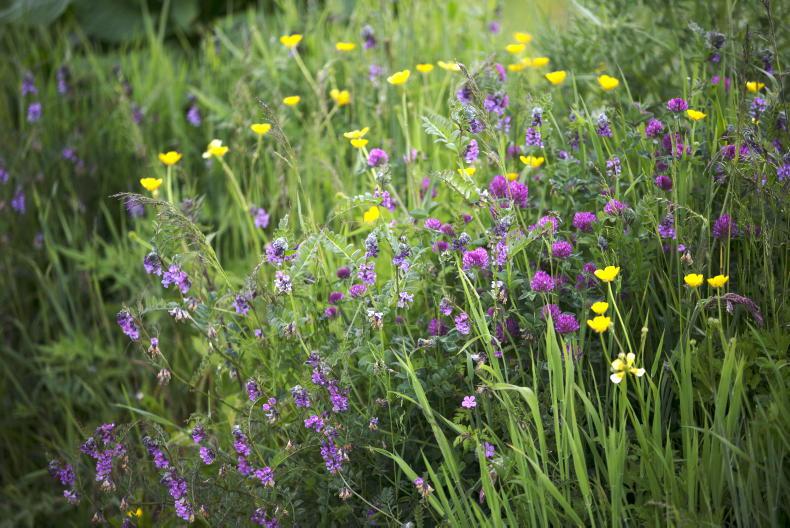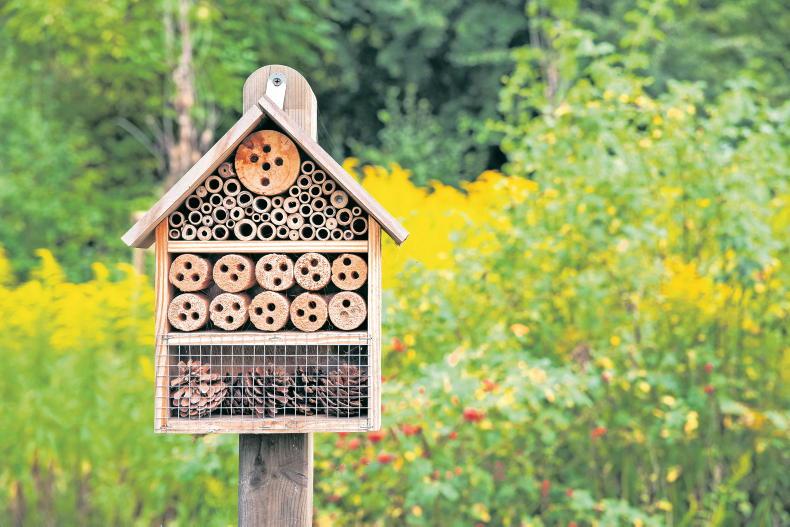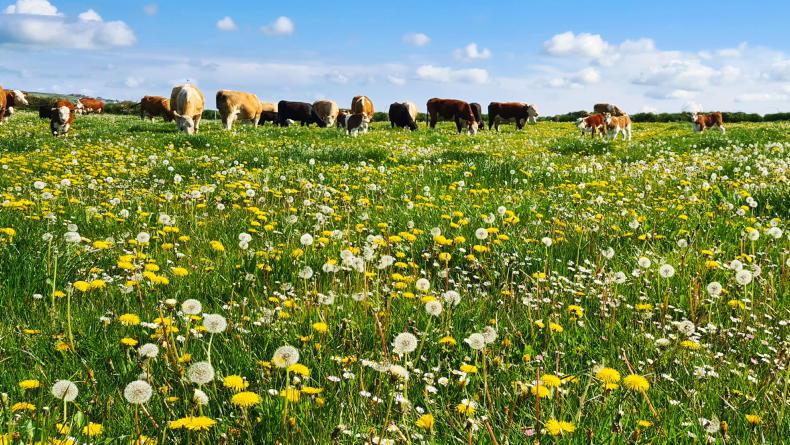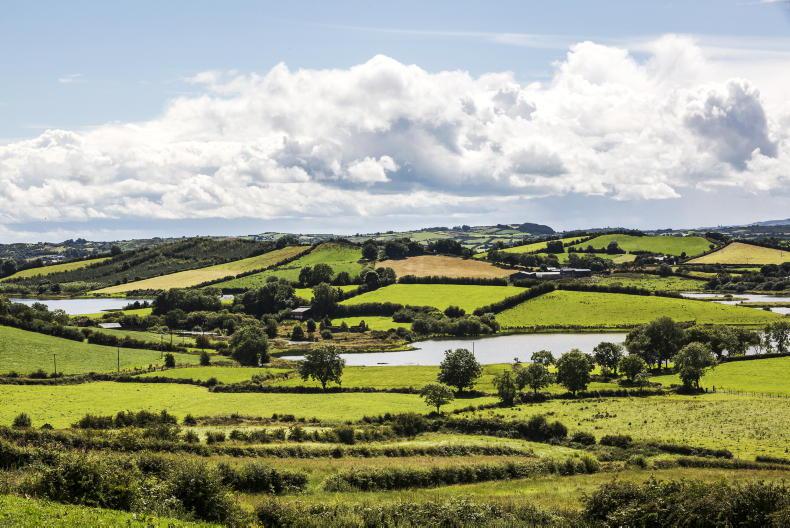Sustainable farming is farming that meets the needs of existing and future generations, while also ensuring profitability, environmental health and social and economic equity. Below are simple ways to increase sustainability on the farm.
Prioritising biodiversity
Biodiversity includes all plant and animal species, as well as other micro-organisms that grow and live around the farm. Biodiversity is flora, fauna and the habitats in which they exist. Some habitats have more flora and fauna than others, such as native woodland, watercourses, hedges and field margins.
To improve biodiversity on the farm, it is important that farmers assess the condition of all habitats on the farm and aim to maintain these through best practice hedge trimming or using less pesticides. Habitats in poor condition can be improved or new habitats can be created, for example by planting a new hedge.

Buttercups, red clover, nettles and thistles in hedgerows.
Hedgerows are important habitats for a number of reasons. Firstly, they improve water quality by trapping soil particles and prevent flooding. Hedgerows also act as stockproof fences and are important wildlife habitats.
Hedgerows provide important habitats for birds and other small mammals such as the hedgehog. Barn owls also use hedgerows to hunt for prey, like the field mouse. A network of hedges around the farm act as a wildlife corridor which allows birds, bats and butterflies to travel through the farm.
Improving biodiversity on farms also helps pollinators such as bees. Bees are needed on farms for the pollination of food crops such as oilseed rape, apple, peas and beans. They also have a role to play in the pollination of wild flowers and trees and the production of honey. Farmers can help bees in many ways.

Bees are needed on farms for pollination of food crops such as oilseed rape, apple, peas and beans.
This includes allowing space for a range of wildflowers to grow and fencing off field margins from livestock. In terms of what type of hedgerow will benefit bees most, one that has lots of flowering plants with mature trees and wildflowers is best.
Farmers can also make bee boxes to help pollinators. To make a bee box, wood that is not treated with an insecticide should be used. There should be a selection of hole sizes, from between three-eights and one-quarter inch. There should also be a selection of holes that should include hollow stems, for example bamboo. Holes must also not interconnect – they must have a dead-end. Packing with subsoil is also recommended as a substitute for a clay bank.

Bee box.
When positioning a bee box, it is important to have the box near flowering plants, at least 40cm off the ground, in a sheltered and sunny spot facing south to southwest and fixed firmly.
Ensuring good soil health is another way in which farms can improve their sustainability. There are some simple ways to check the soil health on the farm. One is by simply taking a spade and digging a hole. You can then see if the soil breaks up easily, if it is compacted or if the soil is active, i.e if there are earthworms present or how deep the plant roots are.

Suckler cows grazing a pollinator-friendly sward.
Another fun way to check soil health involves burying a pair of cotton underpants. This allows farmers to examine the microbial activity within the soil. Cotton is both a source of carbon and a source of food for bugs and micro-organisms.
The underpants are buried and two months later, they are dug up again. If there are lots of holes present and most of the underpants are gone, this means you have a healthy soil. However, it most of the underpants remain, it means that the soil biology needs to be increased and that straw or farmyard manure should be added to the soil.
Sustainable farming is farming that meets the needs of existing and future generations, while also ensuring profitability, environmental health and social and economic equity. Below are simple ways to increase sustainability on the farm.
Prioritising biodiversity
Biodiversity includes all plant and animal species, as well as other micro-organisms that grow and live around the farm. Biodiversity is flora, fauna and the habitats in which they exist. Some habitats have more flora and fauna than others, such as native woodland, watercourses, hedges and field margins.
To improve biodiversity on the farm, it is important that farmers assess the condition of all habitats on the farm and aim to maintain these through best practice hedge trimming or using less pesticides. Habitats in poor condition can be improved or new habitats can be created, for example by planting a new hedge.

Buttercups, red clover, nettles and thistles in hedgerows.
Hedgerows are important habitats for a number of reasons. Firstly, they improve water quality by trapping soil particles and prevent flooding. Hedgerows also act as stockproof fences and are important wildlife habitats.
Hedgerows provide important habitats for birds and other small mammals such as the hedgehog. Barn owls also use hedgerows to hunt for prey, like the field mouse. A network of hedges around the farm act as a wildlife corridor which allows birds, bats and butterflies to travel through the farm.
Improving biodiversity on farms also helps pollinators such as bees. Bees are needed on farms for the pollination of food crops such as oilseed rape, apple, peas and beans. They also have a role to play in the pollination of wild flowers and trees and the production of honey. Farmers can help bees in many ways.

Bees are needed on farms for pollination of food crops such as oilseed rape, apple, peas and beans.
This includes allowing space for a range of wildflowers to grow and fencing off field margins from livestock. In terms of what type of hedgerow will benefit bees most, one that has lots of flowering plants with mature trees and wildflowers is best.
Farmers can also make bee boxes to help pollinators. To make a bee box, wood that is not treated with an insecticide should be used. There should be a selection of hole sizes, from between three-eights and one-quarter inch. There should also be a selection of holes that should include hollow stems, for example bamboo. Holes must also not interconnect – they must have a dead-end. Packing with subsoil is also recommended as a substitute for a clay bank.

Bee box.
When positioning a bee box, it is important to have the box near flowering plants, at least 40cm off the ground, in a sheltered and sunny spot facing south to southwest and fixed firmly.
Ensuring good soil health is another way in which farms can improve their sustainability. There are some simple ways to check the soil health on the farm. One is by simply taking a spade and digging a hole. You can then see if the soil breaks up easily, if it is compacted or if the soil is active, i.e if there are earthworms present or how deep the plant roots are.

Suckler cows grazing a pollinator-friendly sward.
Another fun way to check soil health involves burying a pair of cotton underpants. This allows farmers to examine the microbial activity within the soil. Cotton is both a source of carbon and a source of food for bugs and micro-organisms.
The underpants are buried and two months later, they are dug up again. If there are lots of holes present and most of the underpants are gone, this means you have a healthy soil. However, it most of the underpants remain, it means that the soil biology needs to be increased and that straw or farmyard manure should be added to the soil.










 This is a subscriber-only article
This is a subscriber-only article










SHARING OPTIONS: